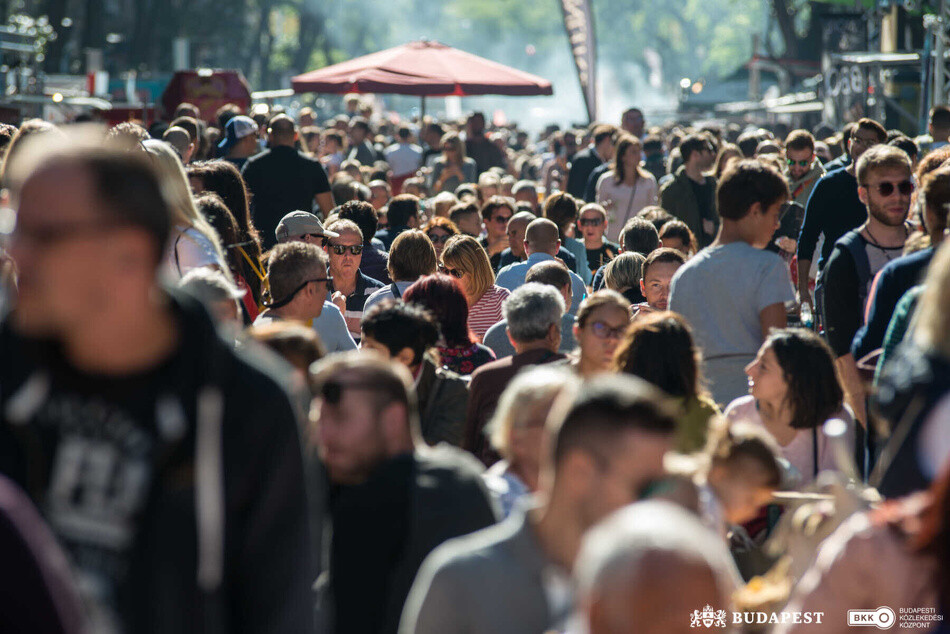
TARTALOM
What is the role of BKK in relation to major events?
What do we call a “major event”?
What traffic changes can we expect around major events?
Public transport
Car traffic
Active and micromobility
BKK's aim is to encourage visitors to use other means of transport instead of cars
What traffic can be expected before, during and after the major event?
How does traffic around the MVM Dome and Groupama Arena change during a sold-out major event (approx. 20,000 people)?
Metro replacement bus M3
Tram line 1
Car traffic
Micromobility
MOL Bubi
Shared e-scooter
Summary
As a global metropolis, Budapest hosts a growing number of major national and international events. One of the biggest challenges in organising these events is ensuring access to and from the venue. The aim is to ensure that the sudden and concentrated demand for travel during major events is managed safely and as quickly as possible, which is a challenge for the transport organiser. BKK Centre for Budapest Transport is responsible for coordinating this task in Budapest.
How do we do all of this? What kind of monitoring do we do? What decisions do we make on the basis of these observations? What kind of traffic changes can you expect when you attend a major event? The following summary answers these questions.
What is the role of BKK in relation to major events?
We are committed to making it as convenient as possible for visitors to get to and from the event venue. To this end, we use various traffic engineering and traffic management solutions, taking into account all modes of transport (public transport, motorised traffic, active and micromobility). In most cases, these requests are not made by the event organiser, but BKK's aim is to ensure that transport services should be provided in an adequate manner.
In order to be able to take the right decisions, we constantly monitor the evolution of transport needs, to which we can respond with operational interventions if necessary. The data collected are also analysed ex-post to plan for the next major events, reducing the number of sudden interventions and facilitating travel planning for visitors.
What do we call a “major event”?
The question rightly arises as to what we call a major event. The definition is partly subjective, but let us be clear about what we are dealing with.
Events that start at a specific time in a specific location and end at a specific time can be analysed, so that traffic can be planned in advance.
Examples of such events are major sporting events (e.g., football matches) or concerts. There is no precise threshold for the number of visitors that would make an event "major", but in most cases an event with at least 10-15 thousand spectators in Budapest can be considered as a major event. It depends mostly on the amount and extent of intervention needed to ensure proper access and egress.
What are the most common locations where intervention is usually needed? Typically, the four largest arenas in Budapest are Puskás, Groupama, Papp László Arenas and MVM Dome, all of which are served by high-capacity rapid transit lines, specifically tram line 1, and metro lines M2, M3 and M4.
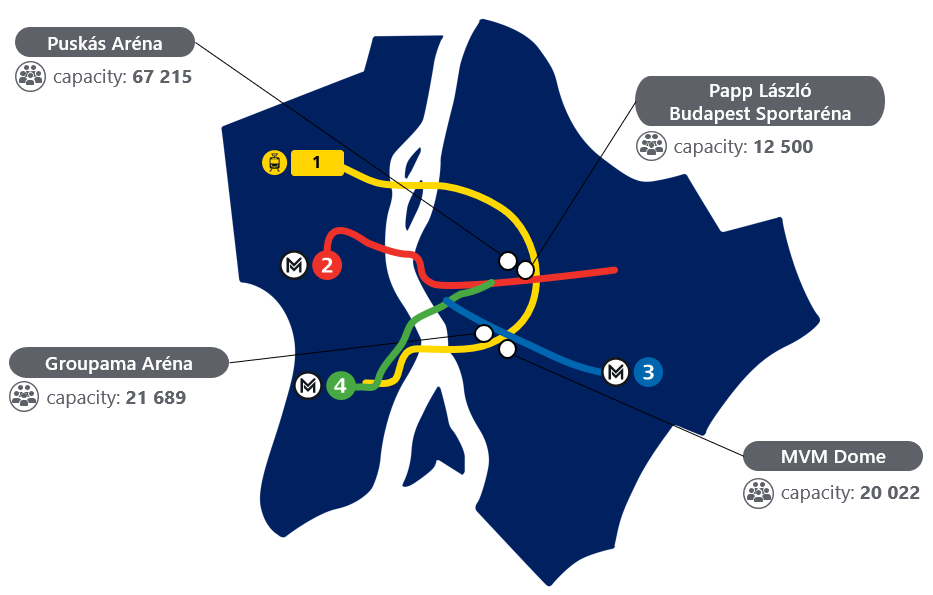
What traffic changes can we expect around major events?
Public transport
Urban public transport services in the vicinity of major events typically run at a higher frequency in the period leading up to the event (usually from the opening of the gates). During the event, normal headways apply to services and then they run at a significantly higher frequency than on a regular day. This extra capacity is accommodated partly according to a pre-planned timetable and partly through the use of operational frequencies depending on the rate at which spectators are leaving the facility. The latter can be achieved by sending reserve vehicles to the site, which are made available before the end of the event.
In most cases, where possible, we recommend the use of fixed-rail transport, as these vehicles have a higher capacity and, and in some cases, buses are diverted due to road closures, which can easily lead to a congestion.
It is always worth checking the BudapestGO journey planning app for any changes, as traffic patterns can change at a short notice depending on the safe coordination of visitor movements.
Car traffic
There are numerous road closures in the area before and after the start of major events. This helps to safely divert the increased pedestrian traffic generated by visitors, as whatever the mode of transport, the last link in the transport chain will almost always be walking.
Congestions can often occur due to closures, increased car traffic and traffic generated by drivers seeking a parking spot. In many cases, for example during events at the Puskás Arena, on-street parking is not allowed in the immediate vicinity of the venue, partly to give priority to pedestrians and to reduce congestion.
Active and micromobility
The venue of major events can be quickly reached by micromobility vehicles (e.g. by bike or scooter). There are several MOL Bubi public bike-sharing stations in the vicinity of the Groupama Arena and MVM Dome. In addition, a variety of shared scooters can also be a suitable alternative means of access. In view of the significant increase in pedestrian traffic, road closures will be in place in the area to ensure safe transport and convenient access to the event venue.
BKK's aim is to encourage visitors to use other means of transport instead of cars
BKK, the city and the organiser of the event have a common interest in transferring individuals from the car to other, more sustainable modes of transport, which can also be more beneficial for the individual. Public transport - especially fixed-rail - is more regular, predictable and less sensitive to disruptions in terms of journey times than car travel, and in addition, there are no parking charges. It is also possible to drink alcohol if you are not driving to the event.
For a major event, a minimum of 10 to 15,000 people should be accommodated. If that many people had arrived by car, this would mean roughly 7,500 to 11,500 vehicles, based on an average occupancy of 1.3 people per car. If we were talking about an occupancy of 4-5 people, we would still be looking at more than 2,500 vehicles.
In the case of stationary traffic, the accommodation of these vehicles in the first case, at 2.5 x 5.5 sqm per car, would take up about 80,000 sqm of space, which is about the same area as the Groupama Arena itself. In the second case, it would "only" occupy roughly 38,000 sqm, equivalent to the area of University Park on BME the campus in Buda. This amount of space is not available in the vicinity of large events, as most of the events are located in the built-up, more inland parts of the city. Approximately 10 lanes of traffic would be sufficient to accommodate this volume of traffic in one hour at 60 km/h.
Using a similar approach, an event at the Puskás Arena would generate the following number of vehicles.
Assuming a full house (65,000 people), an average occupancy of two people/vehicle and that everyone would arrive by car, the length of the moving queue would be about 180 km if they were to follow each other in a single lane. For illustrative purposes, this is virtually the same as the Budapest - Miskolc road distance.
The figure below illustrates how long the queues would be in Budapest if we had considered only those arriving for the event, under the above conditions.
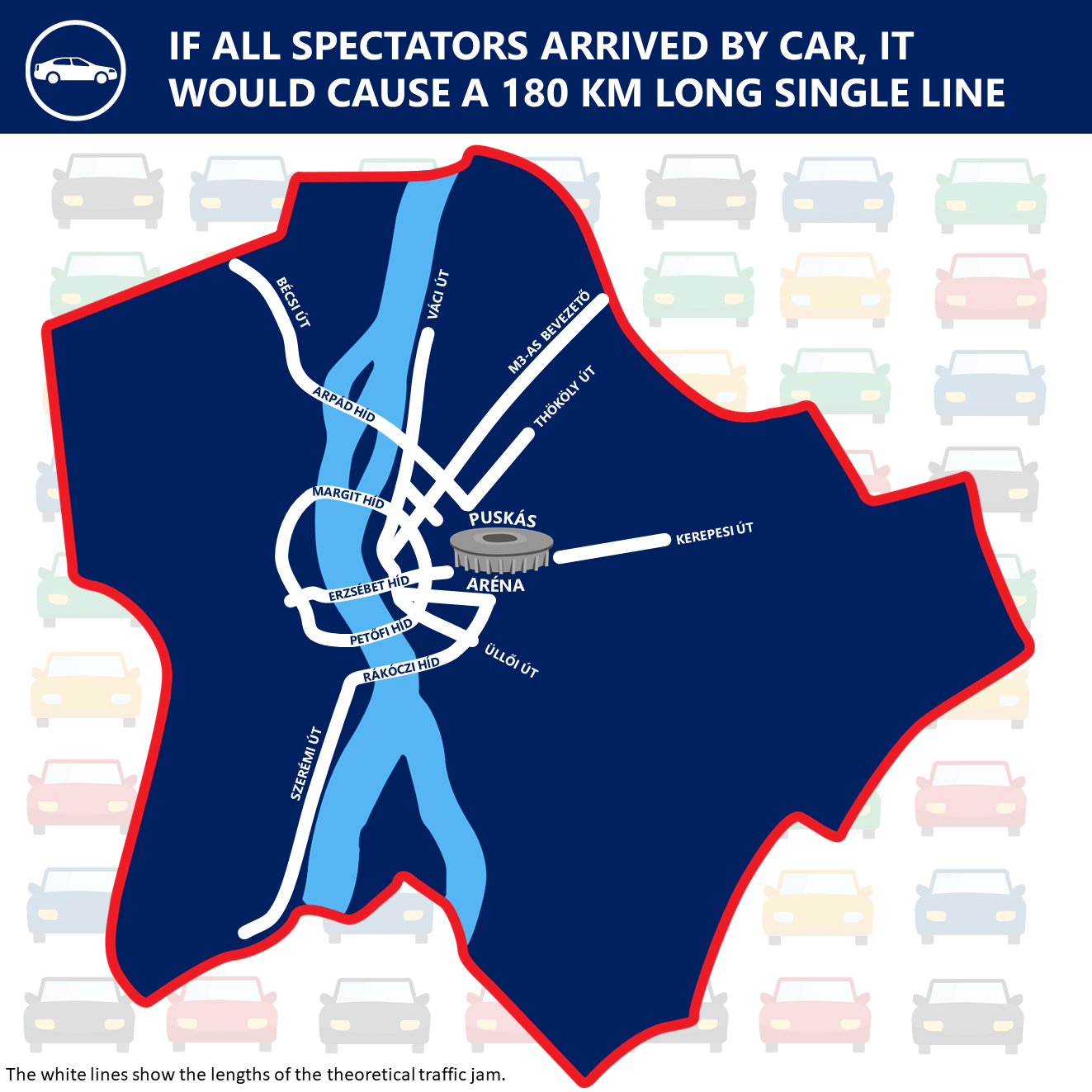
It is therefore worth choosing public transport to get to large events, which not only provides a less stressful journey, but is also a more time-efficient alternative to private cars. We are doing our best to ensure that travel comfort is competitive, but fortunately more and more people are recognising the importance of this, regardless of BKK.
Some sports clubs, for example, are running a campaign offering a gift to ticket holders who arrive at the venue by bicycle.
What traffic can be expected before, during and after the major event?
The figure below shows the flow of traffic in the immediate vicinity of the event on a normal day as well as on a day during a major event before, during and after the event.
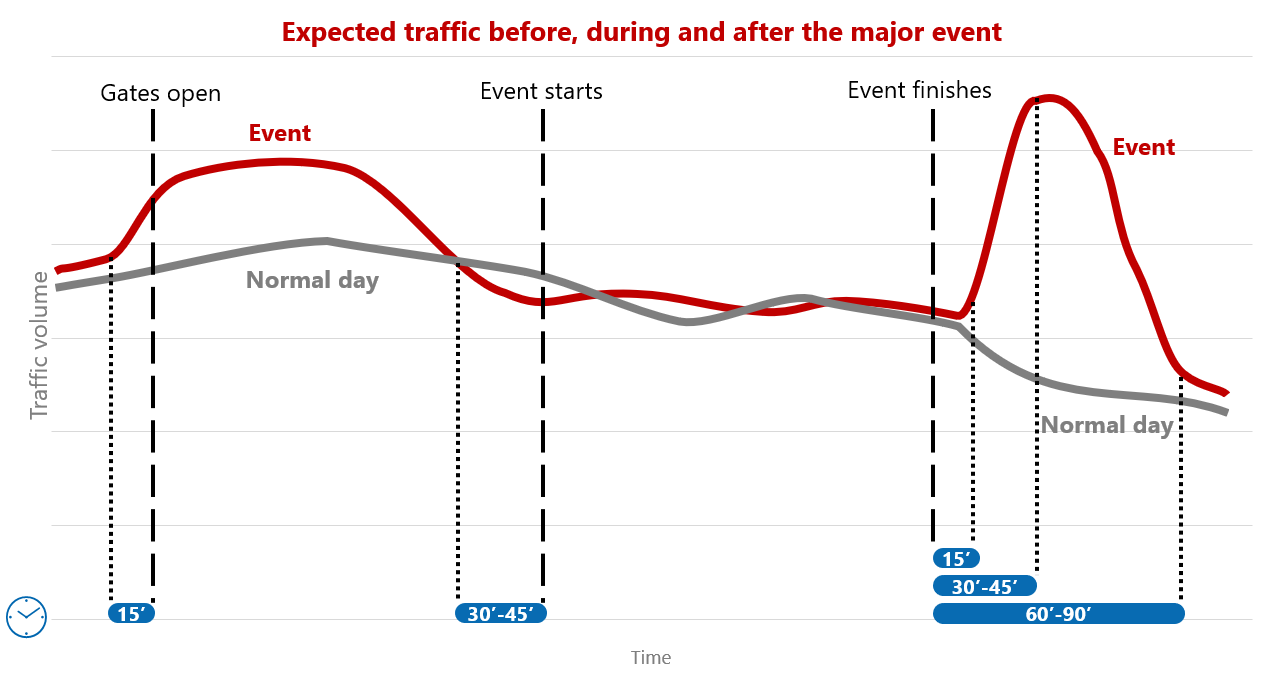
It can be seen that there is an increase in traffic from about 15 minutes before the gates open until about 30-45 minutes before the event starts. By this time, visitors are usually already settled in the facility. In the short period afterwards, until the event starts, there is a minimal drop in traffic compared to the average day. This can be explained by the fact that road users who are not attending the event try to avoid the site, fearing increased traffic.
During the event, traffic is roughly the same as on a normal day. There will be a surge of traffic about 15 minutes after closing time, peaking about 30-45 minutes after the event has finished, and much higher than the pre-event surge, but also subsiding sooner. Normal traffic flow resumes 60-90 minutes after the event has finished (which, in the case of sporting events, may depend on the outcome and the prestige of the match).
How does traffic around the MVM Dome and Groupama Arena change during a sold-out major event (approx. 20,000 people)?
BKK has examined several large events with full capacity at two arenas near Népliget Park (Groupama, MVM Dome). For these analyses, the following events were considered:
- European Handball Championship (EURO 2022) opening match: Hungary vs. the Netherlands, 13 January 2022 (Thursday), starting time: 20:30, (MVM Dome)
- OTP Bank Liga football match: Ferencváros vs.Újpest, 24.04.2022 (Sunday), starting time: 17:30 (Groupama Aréna)
- Champions League qualifying match: Ferencváros vs. Slovan Bratislava, 20.07.2022 (Wednesday), starting time: 20:00 (Groupama Aréna)
For the traffic studies, BKK collected data and conducted observations at the following locations:
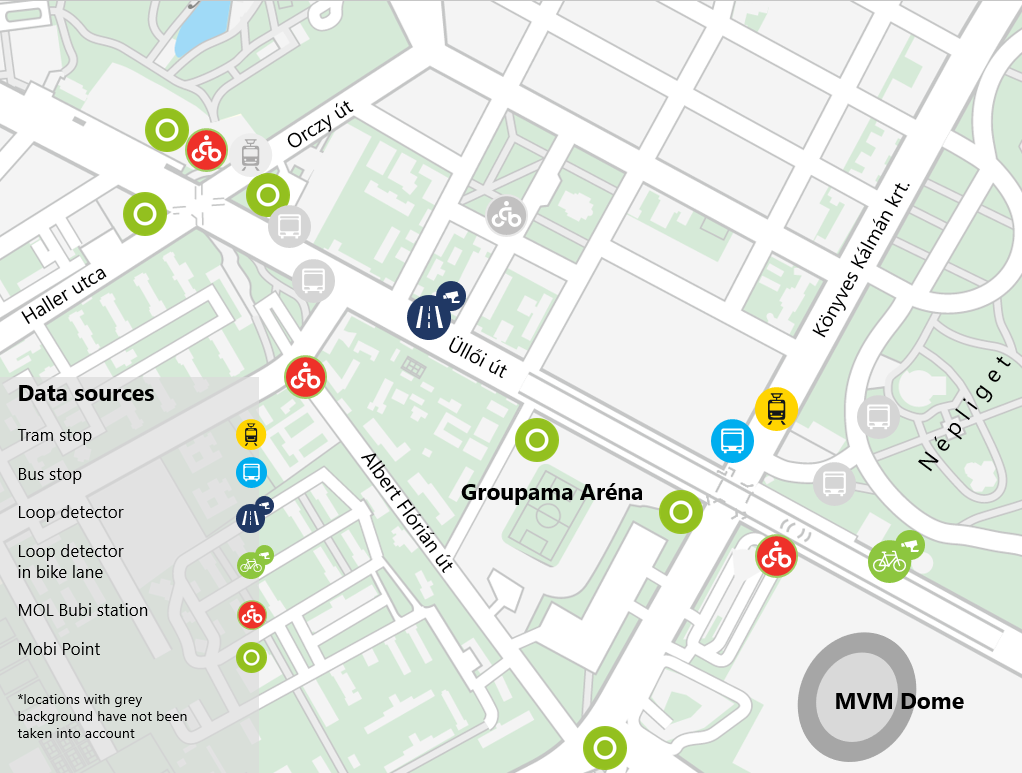
Metro replacement bus M3
Ahead of the big event from 17:30-19:15 on Sunday, traffic was higher than on a normal day. During the event, roughly the same number of passengers was counted, after which there was a significant increase in the demand for travel on the M3 metro replacement buses, based on the number of boarding and disembarking passengers at the stops at Népliget Park, which is adjacent to the venue. It can be seen that the peaks on the day of the event and on a normal day were shifted to different times.
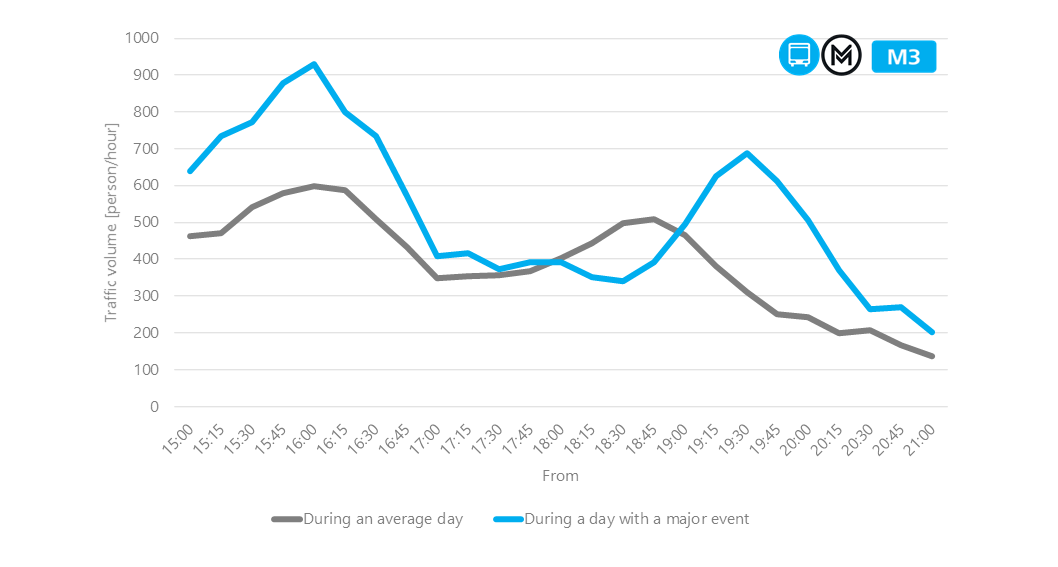
Tram line 1
The diagram shows the extreme increase in passenger traffic compared to the usual level. This type of study makes required service frequency increases more predictable, less operational, thus more schedulable, and it also results in more plannable travel for the passenger. Service frequency increases can be assigned to the type of event with high accuracy. It will be possible to determine when operating periods with shorter headways should start and end and, in the case of scheduled frequency increases, departures will be more predictable.
Prior to the event, a longer, flatter curve representing passenger traffic increase appeared two hours before the game starting throw-off due to the opening ceremony. And after the event, the peak was higher and shorter than before - people arrived at the stop in spurts, and the spike in demand ended about 1 hour 15 minutes after the end of the game (about 21:55). The post-game pattern is similar to that in the case of M3 metro replacement buses.
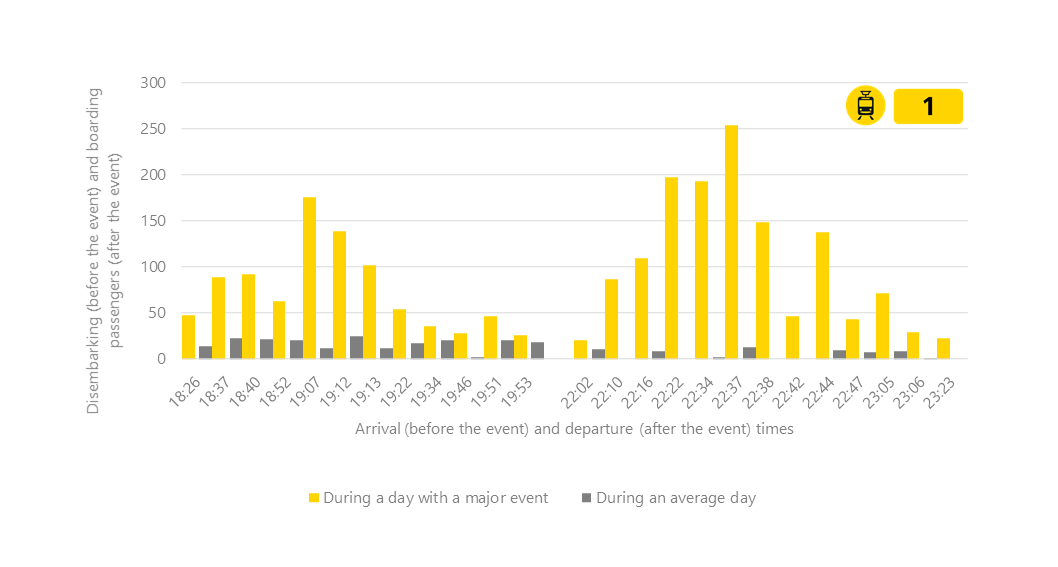
Car traffic
The graph below shows that car traffic on the day of the event, prior to the start of the event, was slightly higher than usual. During the match, the traffic volume was roughly the same as on normal days, but after the end of the event there was a significant jump in traffic load on the roads. This could lead to congestion. Major vehicle traffic dispersed between 60 and 90 minutes after the end of the event.

Micromobility
The venue of large events can also be quickly reached by micromobility vehicles (e.g., by bicycle or scooter). There are several MOL Bubi public-bike stations in the vicinity of the Groupama Arena and MVM Dome. In addition, a variety of shared e-scooters can also be a suitable alternative means of access.
The diagram below shows that the bicycle counter at Népliget Park on Üllői út, a major thoroughfare, on the side leading to the city centre recorded a spike in micromobility traffic between 16:15 and 17:15, and traffic was higher than usual until the start of the event.
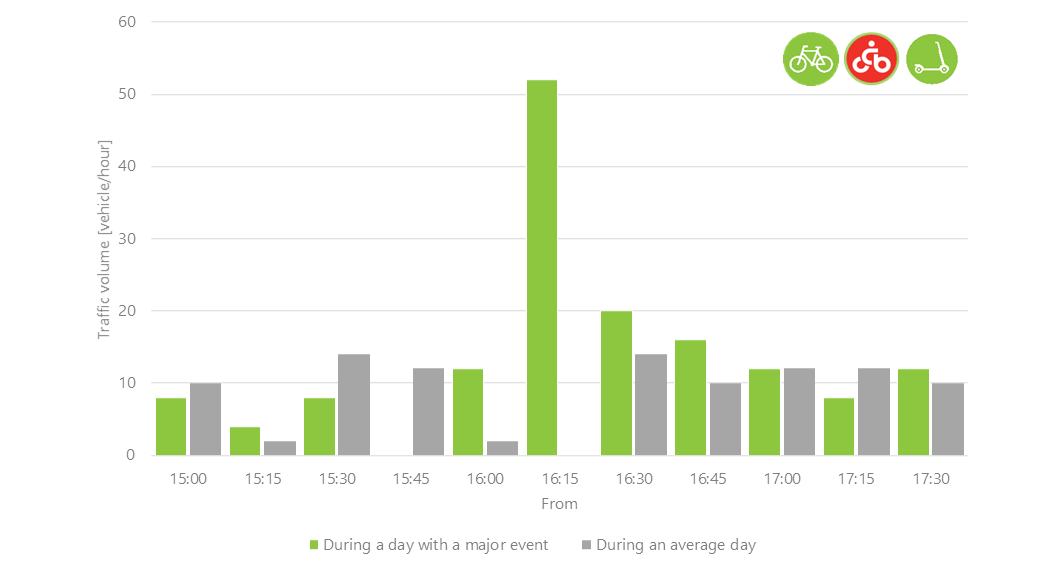
MOL Bubi
The diagram shows the traffic at the MOL Bubi public-bike stations (0817-Nagyvárad tér - NKE, 0919-Nagyvárad tér M (Vágóhíd utca), 0910-Népliget M (bus station)) near the venue during the football match at the Groupama Arena and on normal days - the number of bike drop-offs before the event and the number of pick-ups after the event. Comparing these figures, there was virtually no difference between the two sets of data before the event, but after the event, more than five times as many people used shared public bikes as on a normal day.

Shared e-scooter
We also examined the spatial distribution of departures during the first two hours after the end of the event, between 22:00 and 0:00. Late evening departures are understandably from inner city locations (area within the Grand Boulevard); an area densely populated by restaurants, nightclubs, theatres, etc. The area around Nagyvárad tér (square) and the Groupama Arena has a total of four departures out of 689 in the whole city on a normal day.
![Territory distribution of shared scooters’ pick ups in Budapest between 22:00 and 0:00 [source: Populus]](https://bkk.hu/static/content/2022/12/nagyrend_mikro_helyszin.png)
[source: Populus]
The departures following the match on 20 July were typically concentrated on the Üllői út axis, but due to the spatial distribution of the scooters, the departure points also stretched towards Könyves Kálmán körút, the outer boulevard. The locations highlighted in bold account for 9.2% of all departures in the period under study. A total of 50 departures were recorded, which rivals the most popular points of departure - Erzsébet tér and Deák Ferenc tér squares in the city centre - in this period.
Summary
The table below summarises the traffic growth rates before and after the event at the Groupama Arena compared to a normal day for different transport modes.
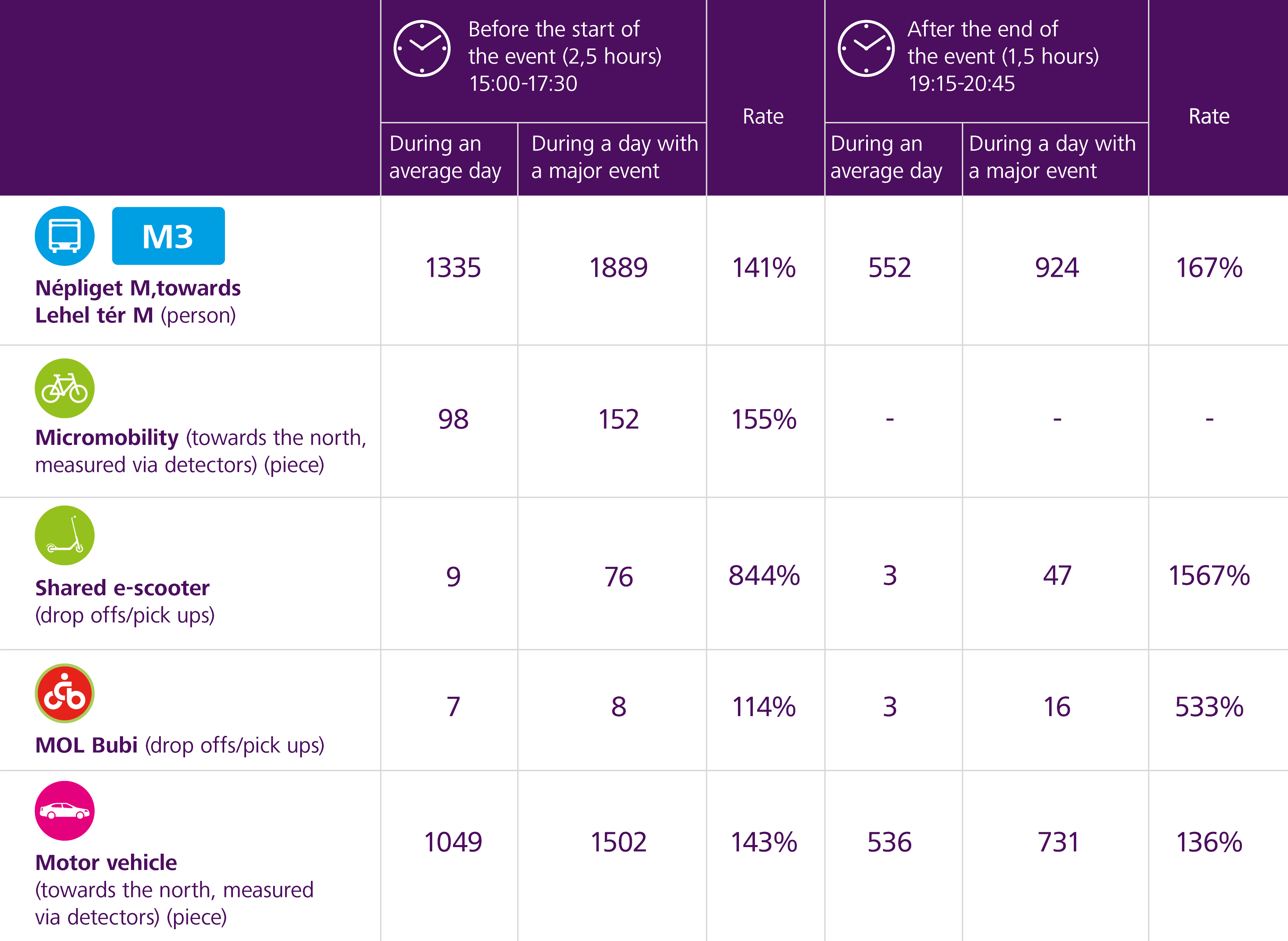
The number of people using public transport services, as well as bicycles and scooters is roughly 1.5 times higher than usual, while car traffic has increased by almost the same proportion. In contrast, the number of people using shared transport modes (MOL Bubi, shared scooter) has increased to a greater extent, but their share is minimal compared to other transport modes in the Groupama Arena area.
Based on the above-mentioned facts, we therefore recommend the use of public transport and micromobility modes instead of private cars to access the venues, in order to facilitate transport around high-capacity facilities and to make mobility more sustainable at urban level. BKK strives to adapt its transport organising activity to this goal as far as possible.



